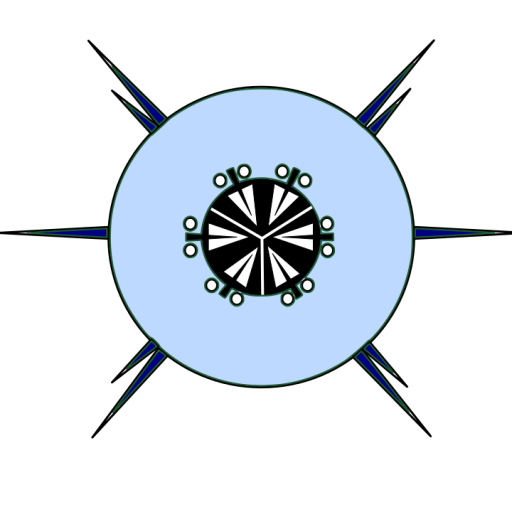A review based on information in the literature indicates that nematode species richness along the coast of Chile in general increases with increasing latitude. However. it is possible to interpret this pattern as a humped distribution with a maximum around 41 °S to 42 °S. The distribution of the samples available in the literature has a bias towards the region between 40 °S and 44 °S, thus, it is difficult to determine if this humped distribution is caused by sampling artifact or a lack of sampling south of 44°. It should be noted that analyses of the diversity of other groups of invertebrates frequently display a dip in diversity between 44 °S and 50 °S (e.g. Valdovinos et al., 2003). This dip could be the result of a lack of sampling in this region of the coast which is extremely inaccessible. A gradient in the species diversity where the species richness increases with increasing latitude is known as an inverse gradient. Inverse gradients have been found for macroalgae (Santelices & Marquet, 1998) and a number of invertebrate taxa along the coast of Chile (Lancelotti & Vasquez, 2000 (Porifera, Amphipoda, Isopoda, Echinoderma and Ascidacea), Valdovinos et al., 2003 (Mollusca), Hernandez et al., 2005 (Polychaeta)). However, ‘classic’ gradients, a gradient where the species richness decreases with increasing latitude, have been found for a number of other invertebrate taxon (Lancelotti & Vasquez, 2000 (Cnidaria, Polychaeta, Mollusca, Decapoda, and macrofauna in general), Rivadeneira et al., 2002 (herbivorous Mollusca), Astorga et al., 2003 (Anomura and Brachyura), Rivadeneira et al., 2011 (Peracarid crustaceans)). Fernández et al. (2009) suggested that groups with direct development like the nematodes would increase in species richness with latitude. Furthermore, they suggested that species with indirect development, i.e. pelagic larvae, would decrease in species richness with increasing latitude. The evidence of the project, with free-living nematodes from exposed sandy beaches, does not support these predictions. One possible problem is that the majority of macroecological studies along the length of the Chilean coast is that data from north and south of 40º is derived from completely distinct habitats, with distinct oceanographic conditions which are not associated with latitude. Between 18 ºS and 40 ºS the coast of Chile consists almost entirely of exposed coasts, rocky shores and exposed sandy beaches. There are no large areas of protected coast and very few large estuaries. Only south of 40º, marked by the Chacao channel, can complex protected coast be found. Exposed coast obviously exists south of 40º but it is extremely inaccessible. The complex coast south of 40º could favor species with direct development over those with indirect development, possibly due to the complex system of fijords and channels which could limit the dispersal potential of pelagic larvae compared to the coast north of 40º which presents few barriers to dispersal. However, samples from protected sites contain abundant nematode assemblages (preliminary data) thus the observed pattern may change when the entire coast (18 ºS to 56 ºS), and all types of sedimentary habitats are taken into consideration.
SST was the environmental variable that best explained the observed pattern in species richness, providing evidence for the ambient energy hypothesis. When nematodes are cultivated in the laboratory under different temperature regimes, those cultivated at the lowest temperatures grow more slowly but achieve larger body sizes (Van Voorhies, 1996). Nematodes on the whole are small and reproduce continuously throughout the year. The length of nematode reproductive cycles is extremely variable, from a few days to over a year (Heip et al., 1985). It is probable that nematodes that live in colder water grow more slowly and take longer to arrive at sexual maturity, thus the number of reproductive cycles per year will be reduced which will restrict population growth. Thus the effect of colder sea water temperatures may be to either prevent a species from colonising the site or prevent a species from persisting at a site when the temperature is below the species optima. There are two possibilities, the species does not have the physiological capacity to survive at the site, or the low temperature increases the length of the reproductive cycle to the point where the population is too small and becomes vulnerable to local stochastic extinction events.
In the case of the pattern of nematode abundance along the coast of Chile, there is evidence that supports the ambient energy hypothesis. But, when spatial autocorrelation is taken into account the hypothesis with the most support is the productivity hypothesis. However the slope of this relationship is effectively flat indicating the the relationship may have little to do with latitude. Nematode abundance decreases with increasing latitude but primary productivity increases with increasing latitude.
The pattern in the variation of mean latitudinal range size supports Rapoport’s rule (Stevens, 1989). This suggests that the nematode fauna of exposed sandy beaches along the coast of Chile has its origins at low latitudes and has dispersed to higher latitudes. This also supports the the hypothesis that temperature is limiting the dispersal of nematodes to higher latitudes.
